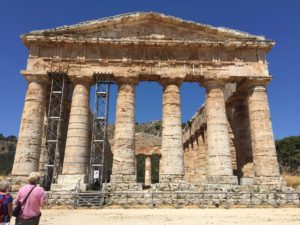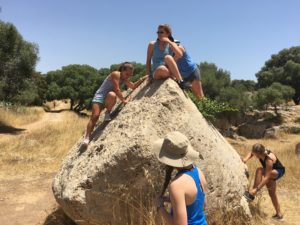Today was a big day in many ways. After a much-needed night’s rest, we met for breakfast around 8 to prepare for a day visiting two rival cities on Sicily- Segesta and Selinunte. Our first full day in Sicily involved hiking, climbing, exploring, and the usual set of challenges awaiting each team.
We first traveled to Segesta to see the partially finished temple as well as the mountain top theater. The Segestans courted different allies in antiquity to help then in their centuries long rivalry with Selinunte. In the 400s BC, they appealed to the Athenians for assistance and support. Athens was trying to consolidate its influence in the Greek world amidst its tensions from its conflict with the Peloponnesian war. Consequently, the Athenians were interested in a wealthy ally in northwestern Sicily. But as Thucydides tells it, the Segestans were not quite as wealthy as they appeared. In fact, Thucydides describes how the Segestans tricked Athens with false displays of wealth in order to gain its support.
The temple in Segesta was begun around this time, but construction never finished. Each team had to document two things about the temple that prove construction never finished. Among the options available are the lack of fluting on the columns and the bosses on the bottom stones used for levering them into place.

After seeing the temple, we went to the top of the mountain and saw the theater. The view looking from the theater across the Sicilian countryside is breathtaking, but the teams were more focused on exploring the acoustics of the space. Sitting about fifty feet away in the stands, one can easily hear whispers from the stage area. Mrs. Pollio led the groups through a discussion about the important role of the theater in Greek like emphasizing the way the plays allowed people to share experience, learn, have catharsis and ultimately live as a more cohesive community.
From Segesta, we drove to the southern plain of Sicily to see Cave di Cusa and Selinunte. Cave di Cusa is a quarry that the people of Selinunte used to construct their temples. When the Carthaginians invaded and sacked Selinunte in 409 BC, the slaves working in the quarry fled. Visiting the quarry today, you can see the drums of future columns partially excavated from the bed rock and ones that were excavated but never transported.

Selinunte’s temples were largely destroyed during the invasion. Hera’s temple has enjoyed reconstruction over the last sixty years or so, but the other two temples we saw are in ruins. The larger, referred to as Temple G since its patron deity remains unknown, was one of the largest temples built anywhere in the Greek world. Today it is in ruins with fig trees and brambles growing amongst the toppled stones. It does provide a wonderful physical outlet for the teams as they navigated their way through the ruins.

Tonight we stay on the southern coast of the island with a view of the Mediterranean from our hotel windows. Tomorrow we are off to Agrigento and the Valley of Temples.
